History
HISTORY OF THE DEPARTMENT
Text: Irena Roterman-Konieczna, Zdzisław Wiśniowski
February 2021 Kraków
The History of the institution, which currently functions under the name of the Department of Bioinformatics and Telemedicine reflects the history of computerization in the Kraków scientific community, if not perhaps the history of computerization in general.
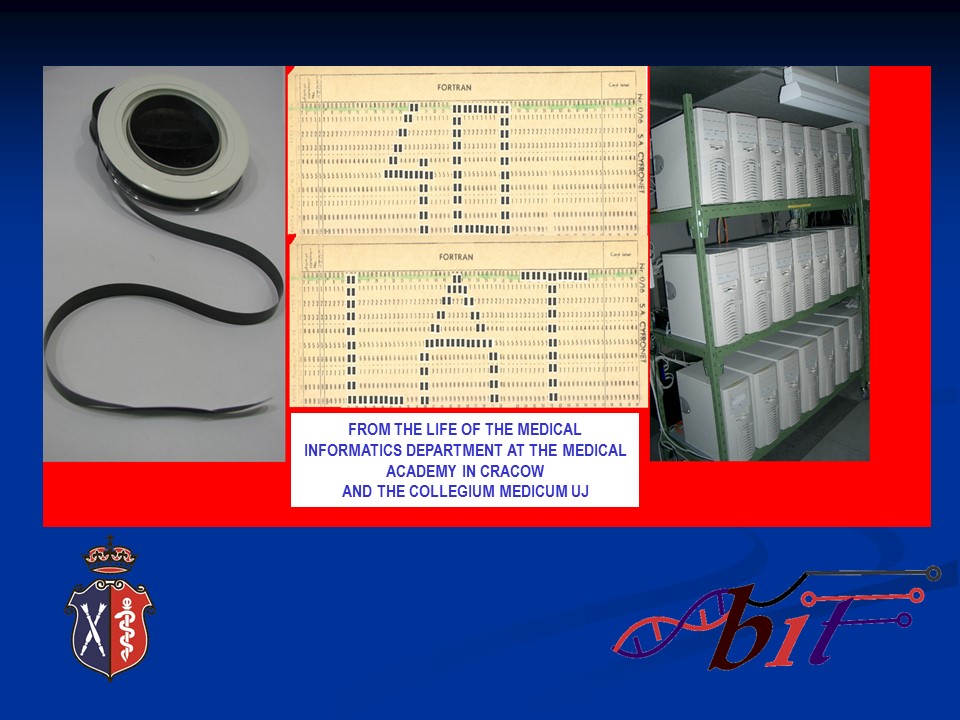
In 2010, our Department celebrated its 40th anniversary. This board takes us back to a time when data carriers took the form of punched cards. All data and computer programs were introduced by means of coded commands and numerical values via holes located in appropriate places on a card. Here the slogan 40 YEARS has been perforated into the card. A few years later magnetic tapes, commonly employed for sound recording purposes and to record and play music, also served as information carriers.
At the time the Department celebrated its 40th anniversary, we were in possession of a large ‘cluster’ of PCs. When the photo was taken, this was the working standard for computing teams.
In its efforts keep pace with advances in the field of computerization our Department has changed its name on many occasions. The diagram illustrates the Department’s history through the different names it has assumed, which in turn reflects the dynamic nature of the standards observed in this discipline. Over the years a new term has emerged – cybernetics or biocybernetics.
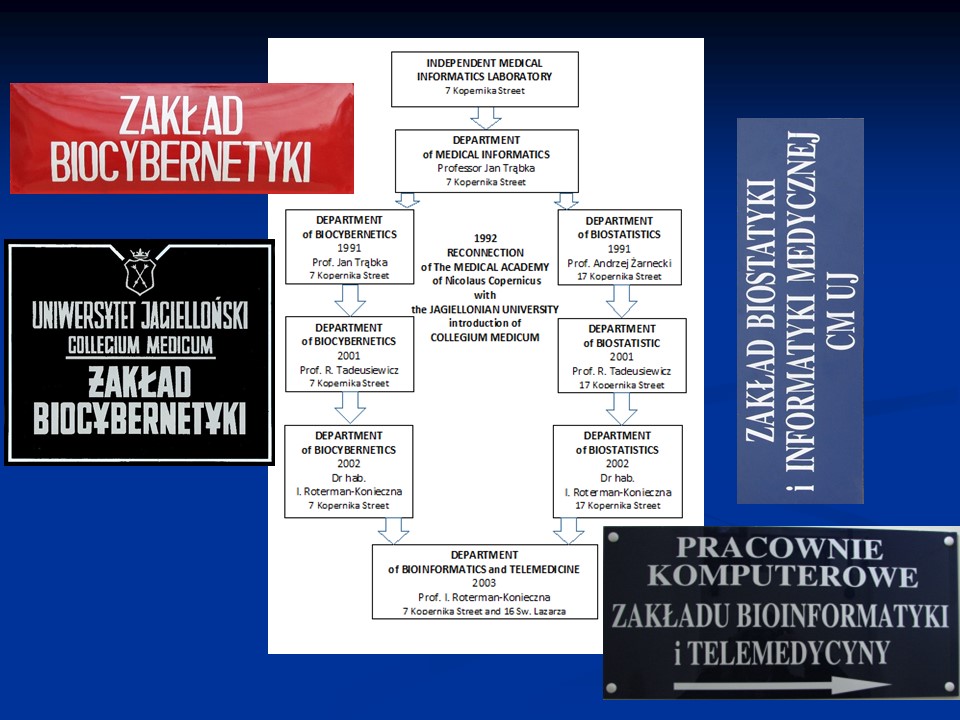
This was the first ever attempt to combine methods based on a systemic and generalized model with domains focused on biological systems research. We might be tempted to say that today’s discipline, i.e., “Systems Biology” represents the latest incarnation of a discipline dealing with the search for a systemic solution to the functioning of a living organism.
For quite a long time, the Department was the only institution of its kind that focused on the use of numerical methods for the medical community in Kraków. This was the era of ‘powerful’ computers. Krakow was home to Cyfronet – the Academic Computer Center, which operated on the basis of what was at that time a rare example of an American computer in Poland – CDC Cyber. Our laboratory had a direct connection to this computer, which was located in the vicinity of AGH. This system was an advance on earlier solutions in that data or program commands were sent via a locally perforated tape. Thanks to this innovation, the necessity of delivering personally large boxes of punched cards to Cyfronet was avoided. Being the only institution of its kind working in the medical community, we performed large-scale calculations for doctors as part of their research work based on analyses of patient data placed at the disposal of the medical community. Thus it was that we came to be known as the Department of “Biostatistics”.
In our efforts to keep pace with the major changes and enormous progress in the field of computerization, we modified both our teaching activities and location in Krakow. The map shows the numerous places where our labs have been based over the years (7 Kopernika Street, 17, 25, 11A Krupnicza Street, Rynek Główny, 16 Św. Łazarza Street, 7 Medyczna Street – not included on the map).

However, no discussion of the beginnings of our Department would be complete without some mention the first ever director of the then Independent Biocybernetics Laboratory, Marek Księżyk, an employee of Cyfronet, with whom we maintained an excellent relationship after he left our Lab.
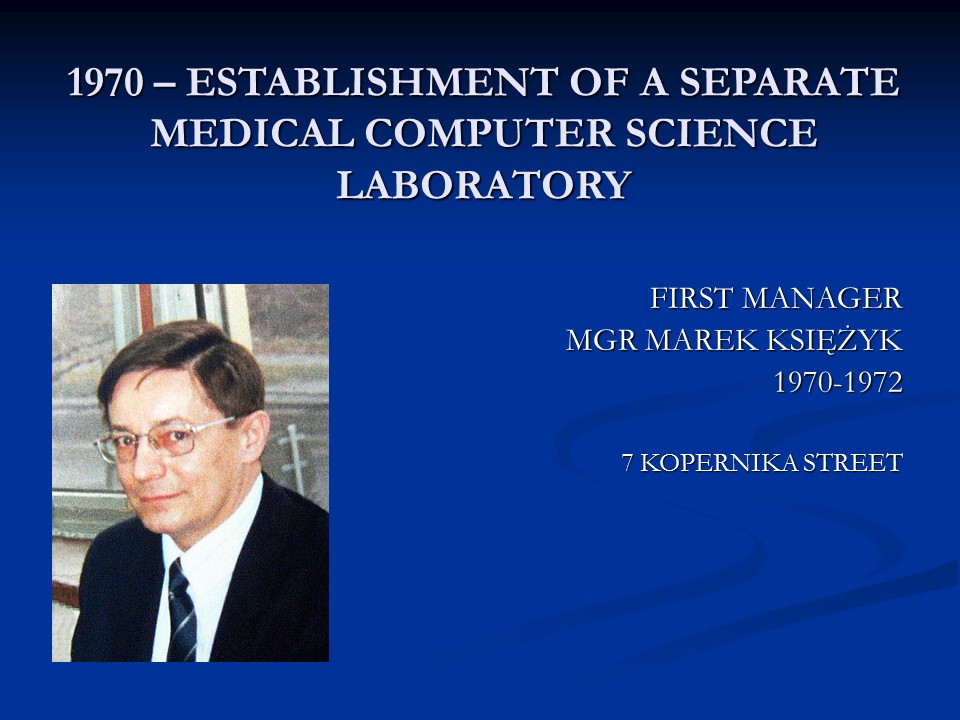
At that time, we often received requests for Marek to, among other things, “push” through tasks and shorten the waiting time for the results of calculations. Accelerating the computing process in this way was vital, given the fact that one often had to wait about a week for some results. At the time we were developing our own programs. Software libraries did not exist at the time and it was impossible to save programs on disk (there was an embargo on computer disks placed on countries from the Soviet bloc). A newly prepared program had to be loaded each time and cards with data added to it. The probability that a program with several hundred punch cards would be loaded error free was quite low. Cards deteriorated over time. Cyfronet featured a room with punching machines, thanks to which a damaged card could be supplemented (replaced) with a new one. The procedure was easy as long as German-made machines were available. Then, the content was coded with an appropriate perforation in a language understandable in the upper bar,. Things got worse with the arrival of Japanese punching machines. The inscriptions were completely abstract. Worse still, sometimes no inscription would appear at all. The ability to read a coded text from the punching system itself became a key asset.
The center equipped with appropriate punch card readers together with the central unit itself – as the processor was called – and the devices transmitting the results are shown in Board.
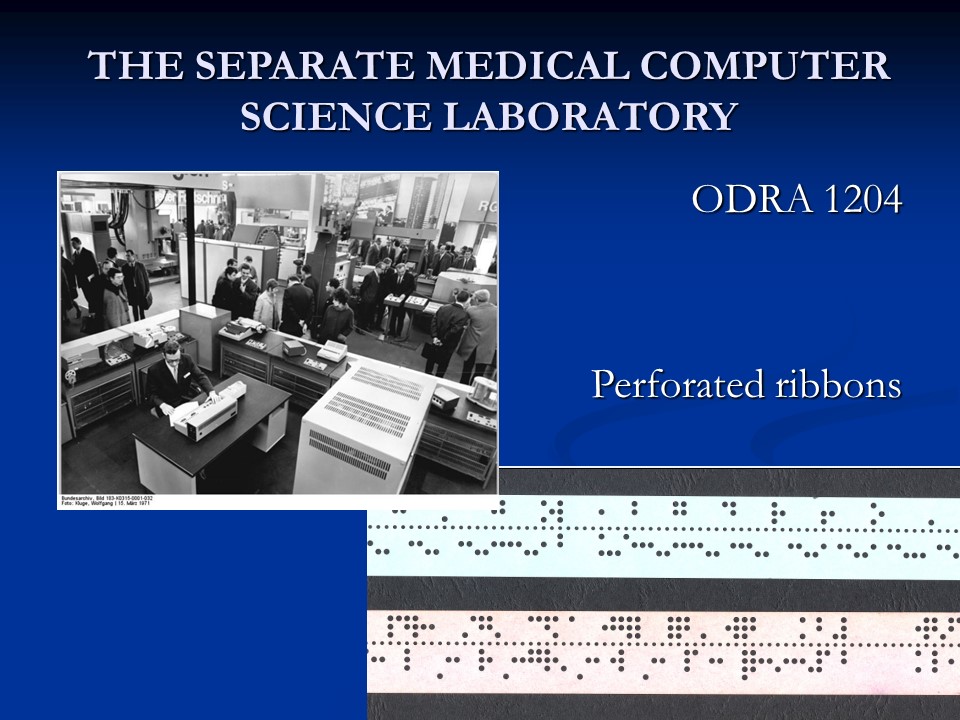
This card operating system greatly facilitated the process compared with the system of the previous era based on punched tapes, a picture of which is shown here. In the latter case, if an error occurred during the perforation process the entire tape had to be copied. After some time, it became possible to glue on the appropriate, corrected place. At a time of general shortages (which is to put it mildly – after all, we are talking about an era when even access to toilet paper was a luxury), getting hold of such glue bordered on a miracle. We can imagine the existence of an “elite” of people who had access to such resources.
At a time when the University Hospital is being moved in its entirety from Kopernika Street to Prokocim district, the buildings that have until now housed units of our Department will soon constitute something akin to an historical document. We were located at 7 Kopernika Street and 25 Kopernika Street to be precise.
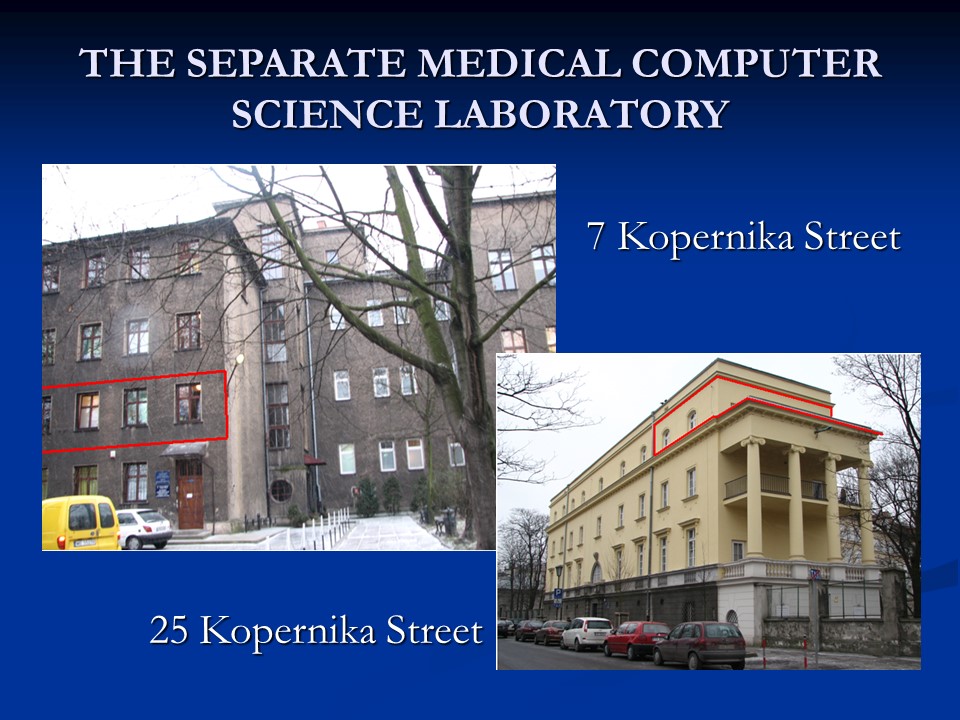
In 1972 the neurologist Professor Jan Trąbka was appointed head of the Department.
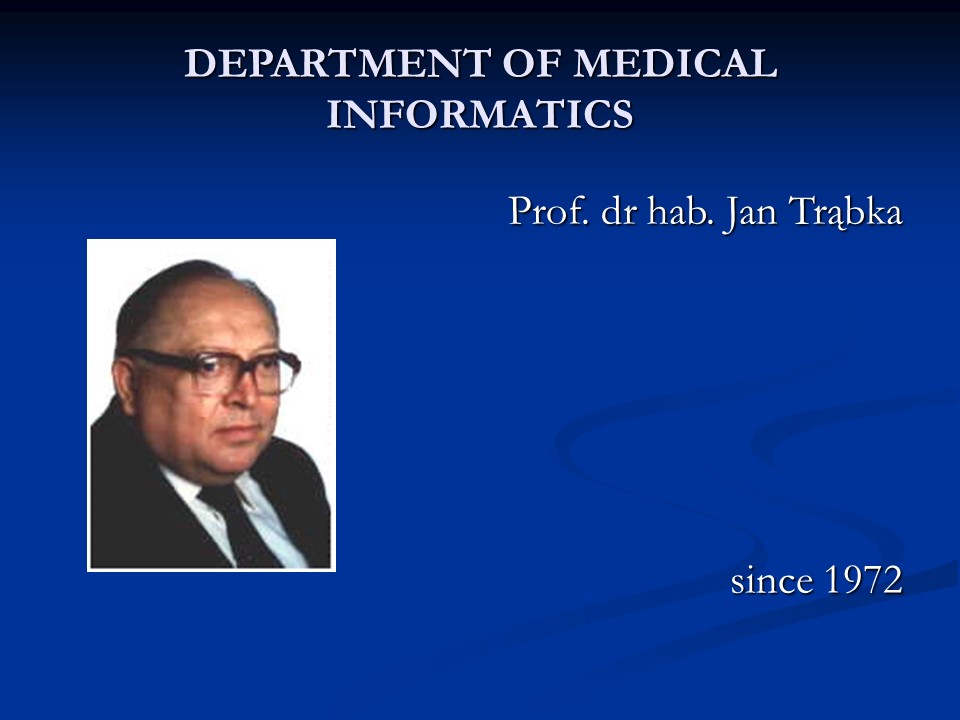
The professor was fascinated by cybernetics and biocybernetics. In his memoires, he mentions his contacts, with none other than Norbert Wiener himself, whom he first met at MIT, where he completed a postdoctoral internship. In its essence, the discipline of neurology implies a significant relationship between the functioning of the nervous system and the communication system traditionally associated with telephones and this type of communication. It might seem obvious to see analogies between two supposedly separate worlds, but for the pioneers of this kind of thinking it was almost revolutionary. It is similar to the amazement caused by the chemical synthesis (in the laboratory) of urea achieved by Friedrich Wöhler in 1828. Until then, urea had only been treated as a product of living organisms, including the human body. Today, viewing interpersonal communication systems separately from the information transfer systems of living organisms and treating the production of a certain compound as the exclusive skill of living organisms, seems ridiculous. And yet someone had to take the first step.
To store already developed programs (it is important to recall that at the time we would write appropriate programs for every doctor) the codes were published in the form of different serial publications. A standardized sheet was prepared for a particular program. It included a set of templates and a description of procedures. One fact that stands out is the poor quality of the product. Almost all books looked like this back then. A colorful picture in a children’s book was an extraordinary phenomenon.
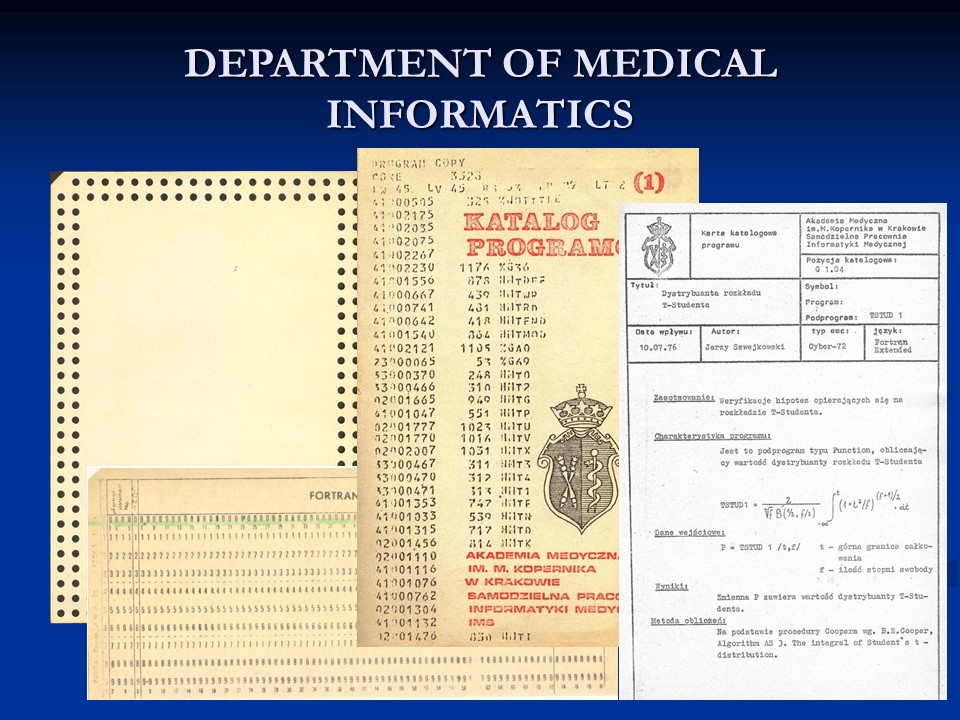
The equipment for punching cards is shown in the photo alongside.
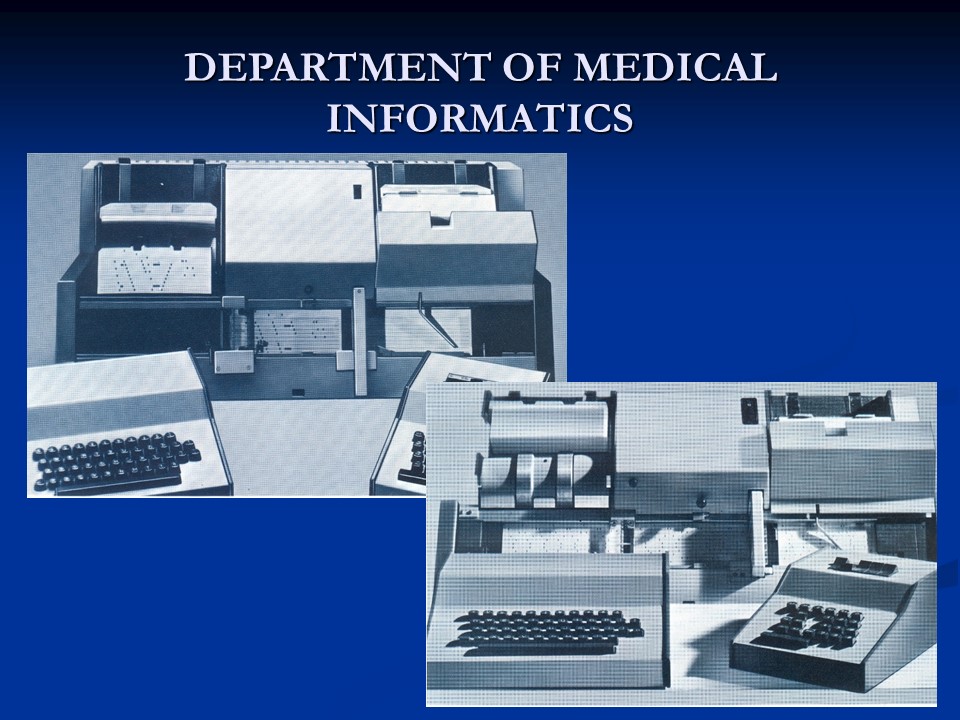
On the right hand side, we see a container for blank cards. In the central part, the card passes through a section where the perforation occurs. On the left hand side, the punched card is transferred to the punched card holder. The codes were entered using the keyboards visible on the board. The machine was quite noisy, which was especially bothersome in the Cyfronet’s user room, which contained six such machines.
A major advance came with the introduction of the magnetic tapes used in tape recorders as data carriers. They ensured that tapes could be used multiple times, although they, too, suffered various forms of damage.

The development and promotion of interdisciplinary research and teaching was accompanied by the appearance of the first scripts – textbooks aimed at both students of medicine at the Medical Academy and students of various technical faculties at AGH.
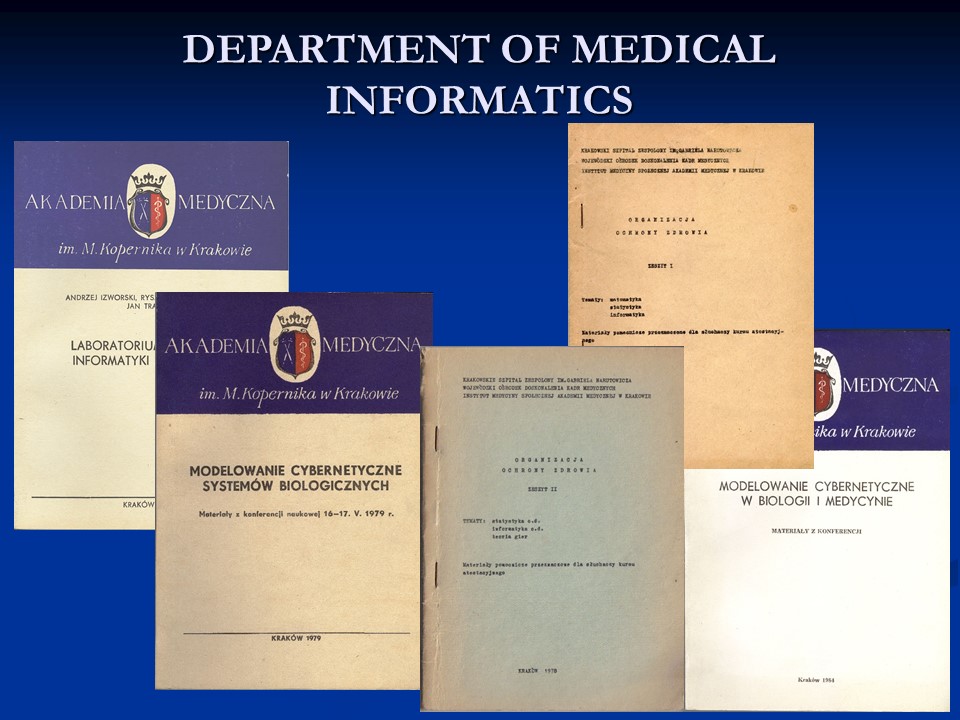
A major scientific community focused on the development of computer systems began to emerge at AGH.
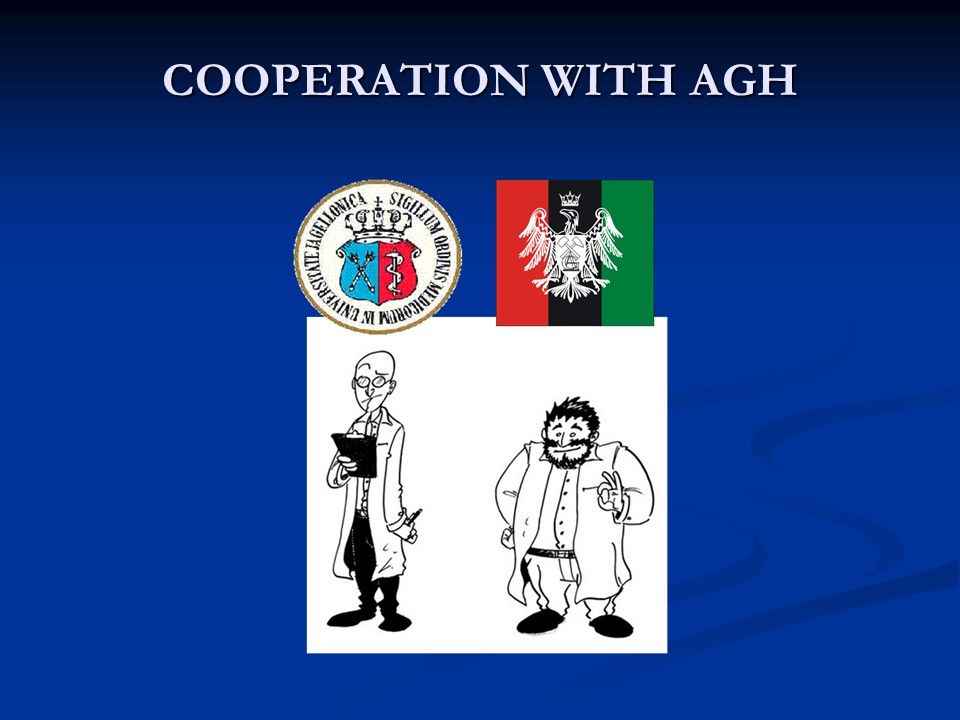
A technical university developing industry-related disciplines relied to a great extent on the possibilities of the Cyfronet center. However, besides specialists working in technical fields, the institution also included pioneers who combined the potential of technical and biological disciplines. Among them was an AGH UST graduate, Professor Ryszard Tadeusiewicz, (at the time possessing a PhD in technical sciences) who simultaneously began a degree in medicine,. Medical researchers began to collaborate on various projects with specialists from technical disciplines, and one of the champions of this approach was Professor Jan Trąbka. This partnership, initiated back in the 1970s, has continued uninterrupted until the present today. The name of Professor Ryszard Tadeusiewicz will appear in this story many times.
One individual who has played a major role in promoting collaboration between AGH and our Department is Professor Antoni Pach, a pioneer in both teaching and research in the field of telecommunications, as well as the founder and first chairman of the Kraków Branch of the Polish Cybernetic Society.
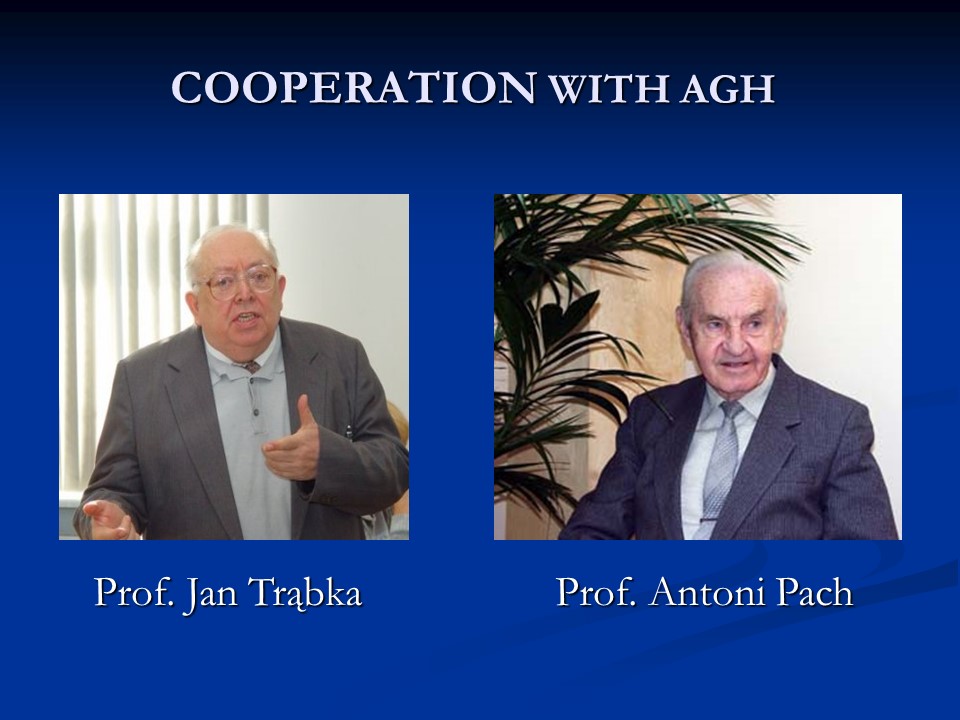
Such interdisciplinary cooperation bore fruit in Professor Ryszard Tadeusiewicz’s doctoral dissertation project, which involved creating an “electronic dog”.
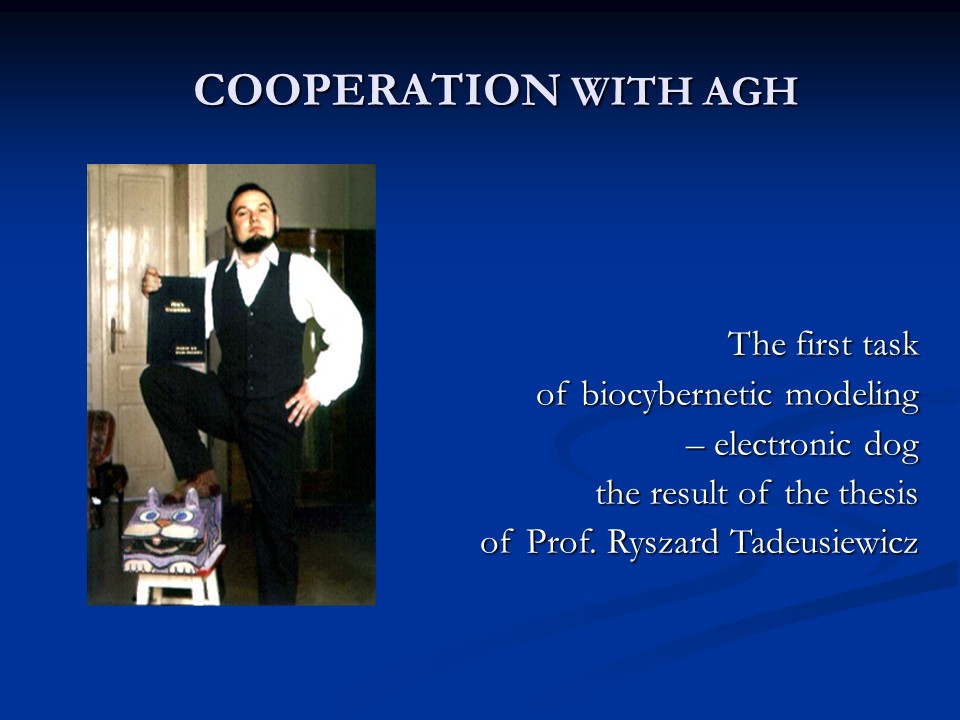
Partnership between the medical and technical communities at AGH also led to the organization of a joint conference, a tradition that has continued until the present day. Joint Conferences on Cybernetic Modeling of Biological Systems (MCBS) have been organized in 5-year cycles.
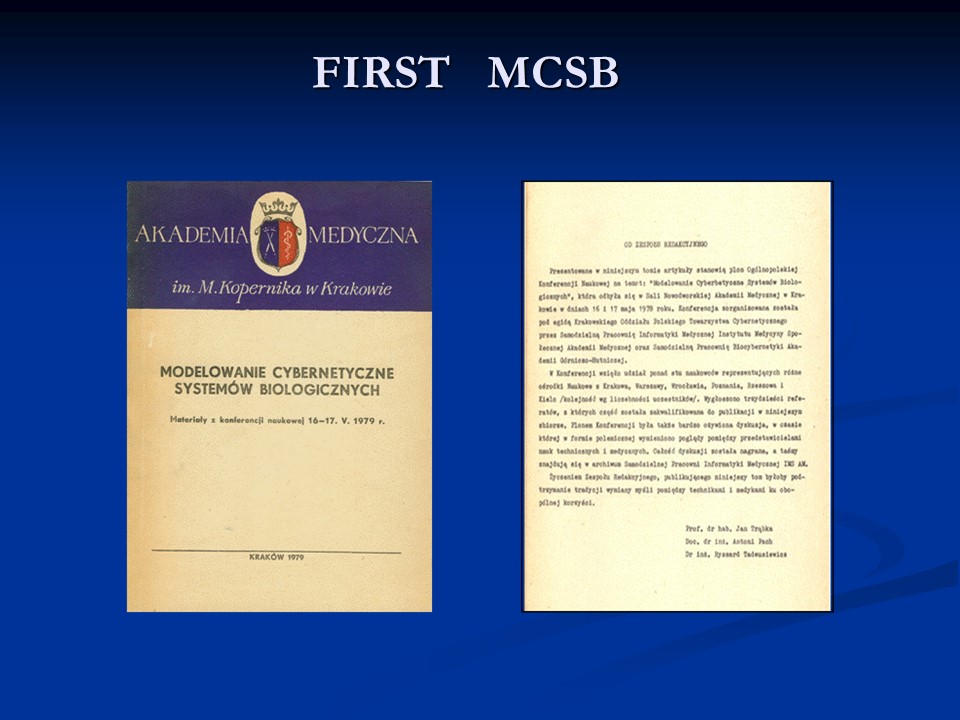
The first of these gatherings took place in 1979. The conference materials assumed the “modest” graphic form typical of the publications of those times.
The development and promotion of interdisciplinary research and teaching was accompanied by the appearance of successive textbooks aimed at both medical students at the Medical Academy and students of various technical faculties at AGH.
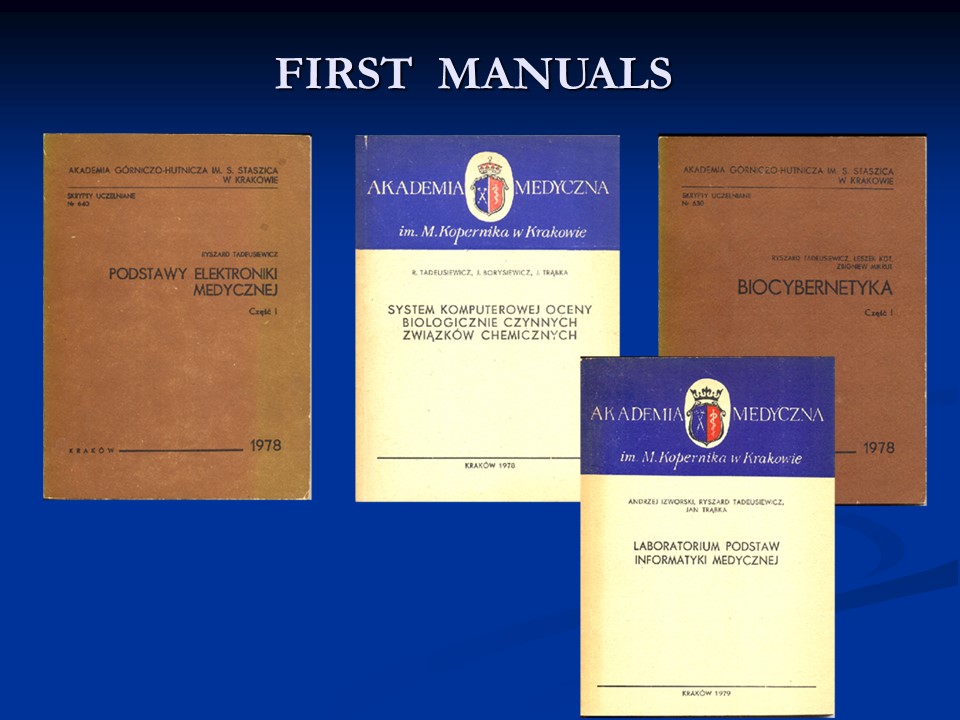
A number of practical solutions were also developed, including specialized calculators, targeted at a particular computing department. Shown here is a statistical calculator.
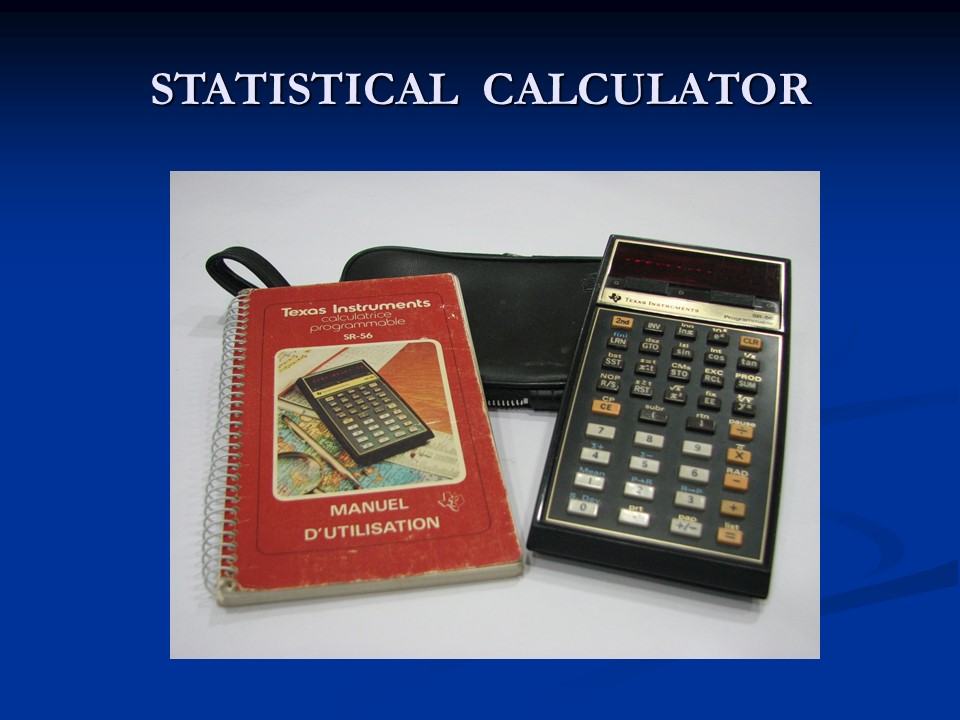
Appropriate statistical calculation procedures were introduced on a permanent basis. All that was required was to enter the data in the correct manner, adjusting to the target procedure, and after pressing a key the user would obtain the result in the form of a statistical value of the test performed. One drawback of earlier solutions had been the need for error-free data entry. The probability of entering data by mistake was fairly high. Using such equipment, especially in the case of small databases, greatly facilitated operations and was a way to overcome dependence on carrying cards in the Cyfronet system.
Our migrations around Krakow (as shown on Board III) included time spent at 11A Krupnicza Street, where we occupied half of the top floor of this building. On the other side there was a Dental Cooperative, which helped ensure our teeth were in good condition. The Małopolska Medical Chamber was also located on the first floor. We had no contacts with this institution, but at least the atmosphere of our ‘neighborhood’ enabled us to “live and breathe medical air”.
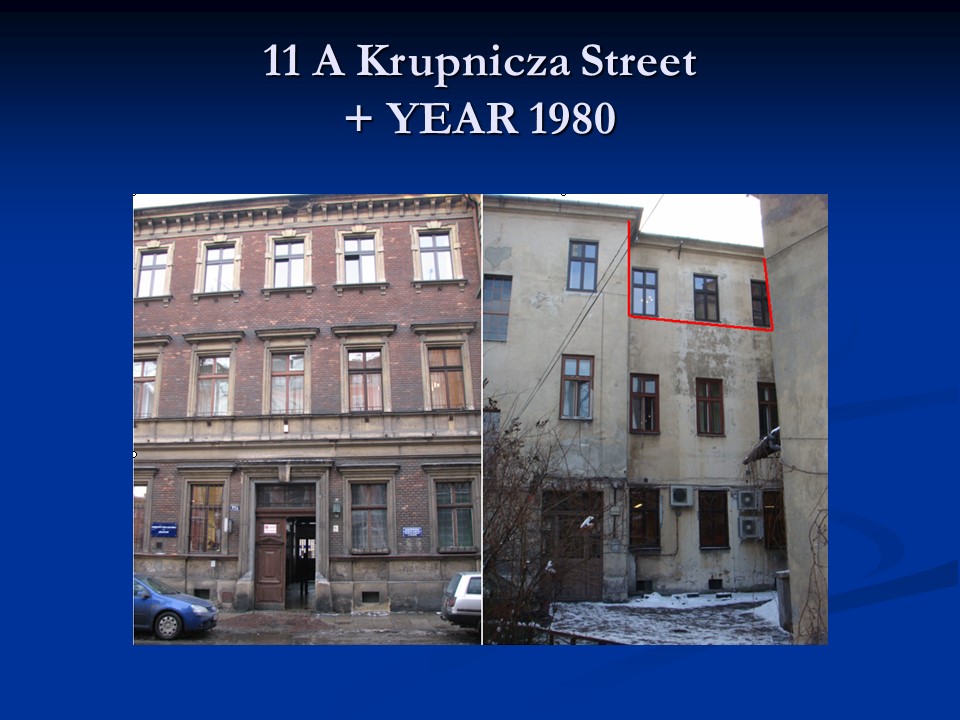
The period when one of our facilities was based on Krupnicza Street coincided with the rise of Solidarity and later the imposition of Martial Law. Due to our proximity to AGH and our role in representing the medical community (at that time in the form of Nicolaus Copernicus Medical University) we set up on our premises a distribution center for the illegal, underground press.

The board shows the cabinet in which illegal (underground) publications were kept They were delivered centrally by employees – young PhD students or doctors (nowadays, honorable professors, and one of the suppliers is a former Vice-Rector of the Jagiellonian University). Our role was to disseminate underground newspapers and bulletins among Kraków’s different institutions of higher education . The board shows just a few of these clandestine publications.
In 1992, when the city’s medical faculties were reincorporated into the Jagiellonian University as Collegium Medicum, the then Department of Medical Informatics was split into two independent units. One of the newly established Departments (the Department of Biocybernetics under the stewardship of Professor Jan Trąbka) dealt with matters of biocybernetics, while the Department of Biostatistics and Medical Informatics, headed by Professor Andrzej Żarnecki, specialized in research and services for doctors active in the field of statistics and the application of information systems in medicine.
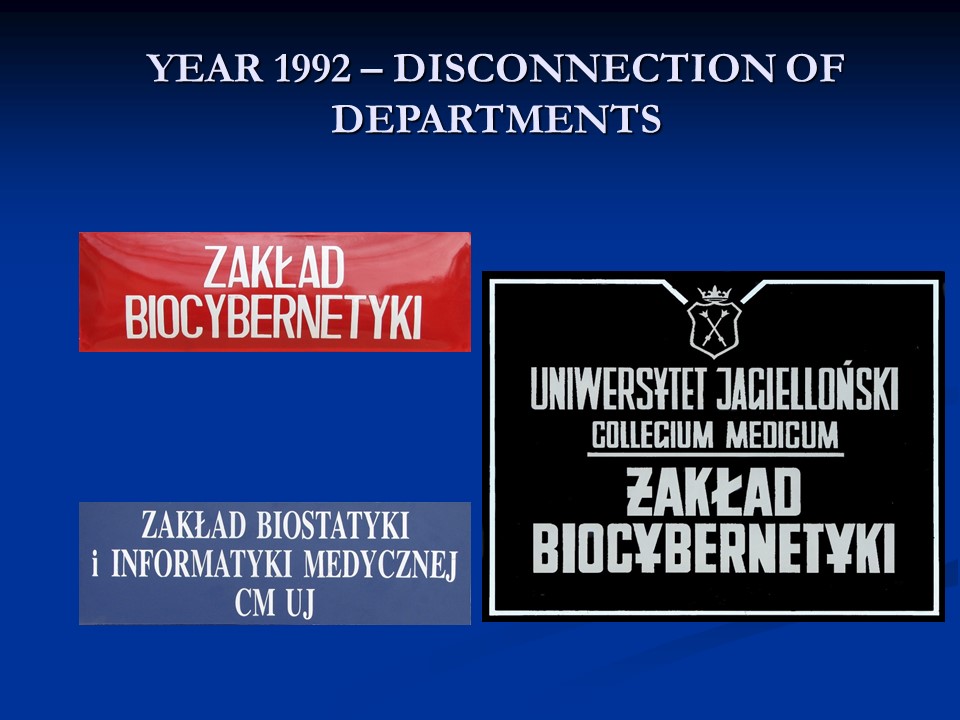
The head of the new unit – the Department of Biostatistics and Medical Informatics – was Professor Andrzej Żarnecki a specialist in agricultural statistics who also headed the Department of Statistics and Breeding Genetics.
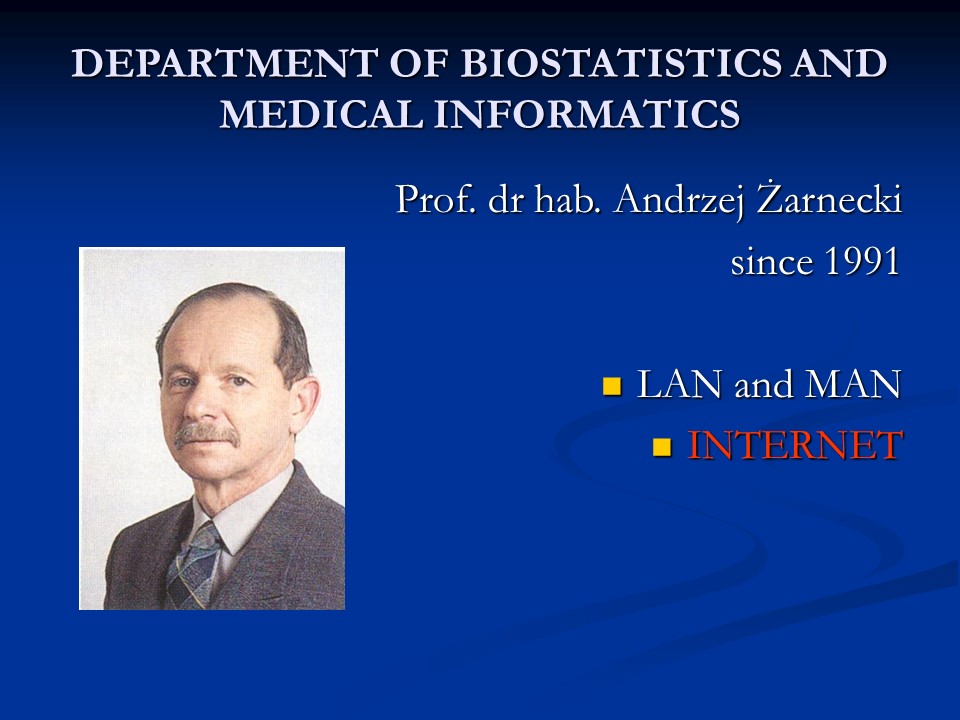
Computer networks and the INTERNET first made their appearance during this period. Cyfronet created and launched MAN (Metropolitan Academic Network), which connected Krakow’s scientific community with the rest of the world. In the years 1995-2000, the Department developed a LAN network for Collegium Medicum, which linked together individual units of the University and provided universal access to the Internet. The use of punch cards and punching machines became a thing of the past. For those who had navigated their way through the Cyfronet with packets of punched cards, the possibility of transmitting data via the new network was a GROUNDBREAKING event. No one needs convincing of the importance of this innovation. We were the generation that experienced this revolution literally.
Other information carriers (besides punched cards) also became obsolete, among them floppy disks. They worked similarly to magnetic tapes, but enabled much faster access to encoded content – data for calculations and programs. The sizes of these floppy disks varied (from 8″ to 3.5″), as did their capacity, design, and, as a consequence, their reliability and susceptibility to mechanical damage.
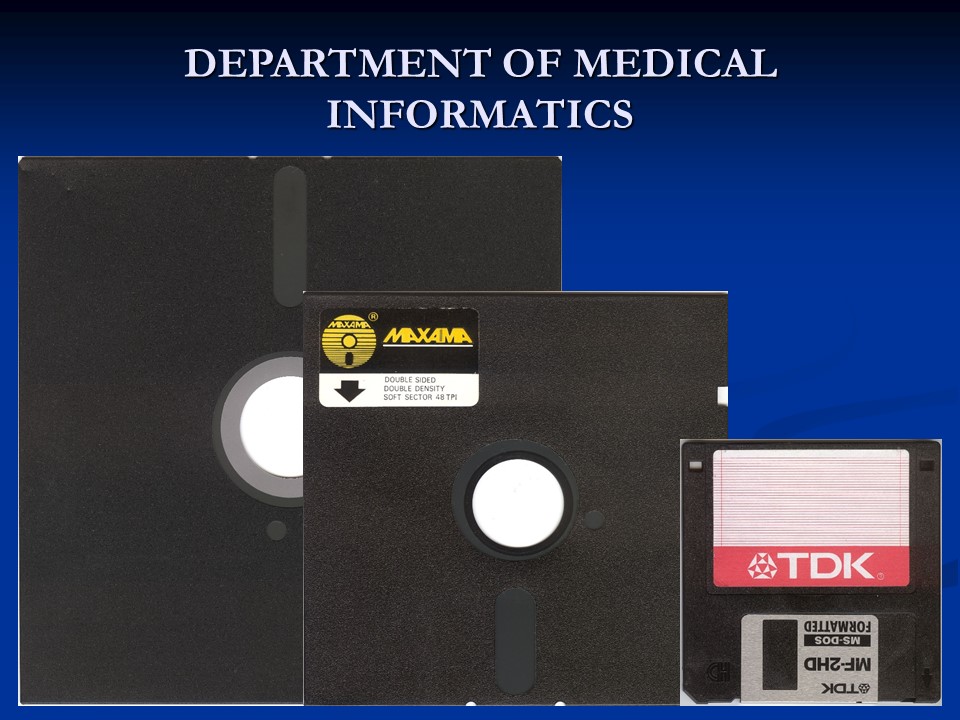
A second REVOLUTIONARY event was MINIATURISATION. Huge computers weighing hundreds of kilos were replaced with small objects in size and weight not exceeding the capabilities of the average person. Thanks to the introduction of printed circuits and integrated circuits everyone could now have access to equipment that only required adequate desk space.
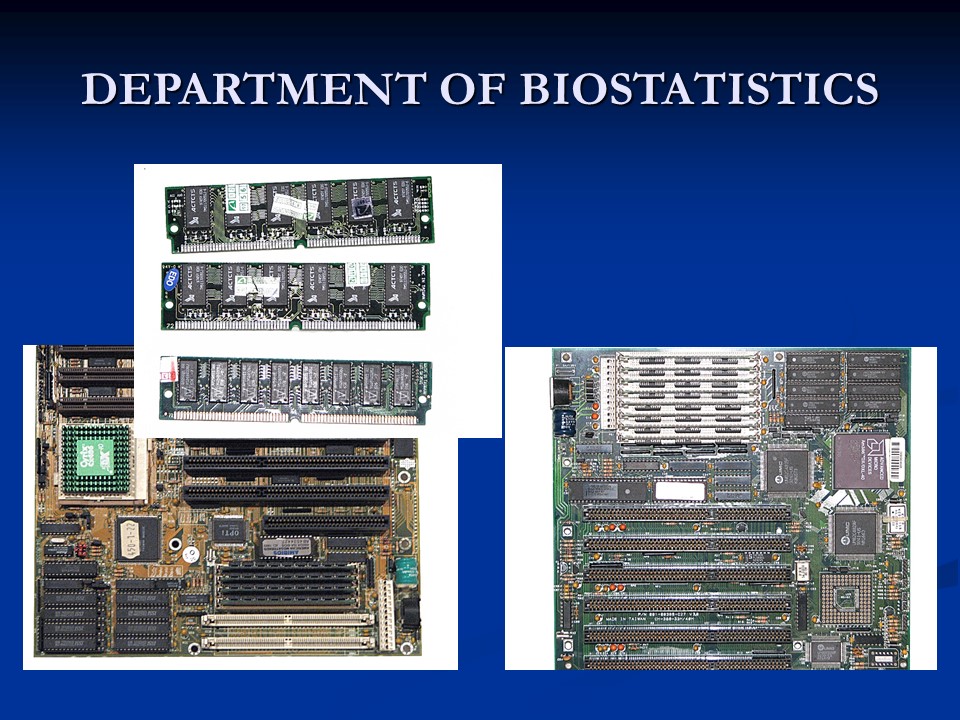
It was miniaturization that led to the development of the Personal Computer (PC, PC). The first models enabled communication between a user and a computer via a keyboard and monitor. Then along came devices that allowed for the input of data stored on magnetic carriers.
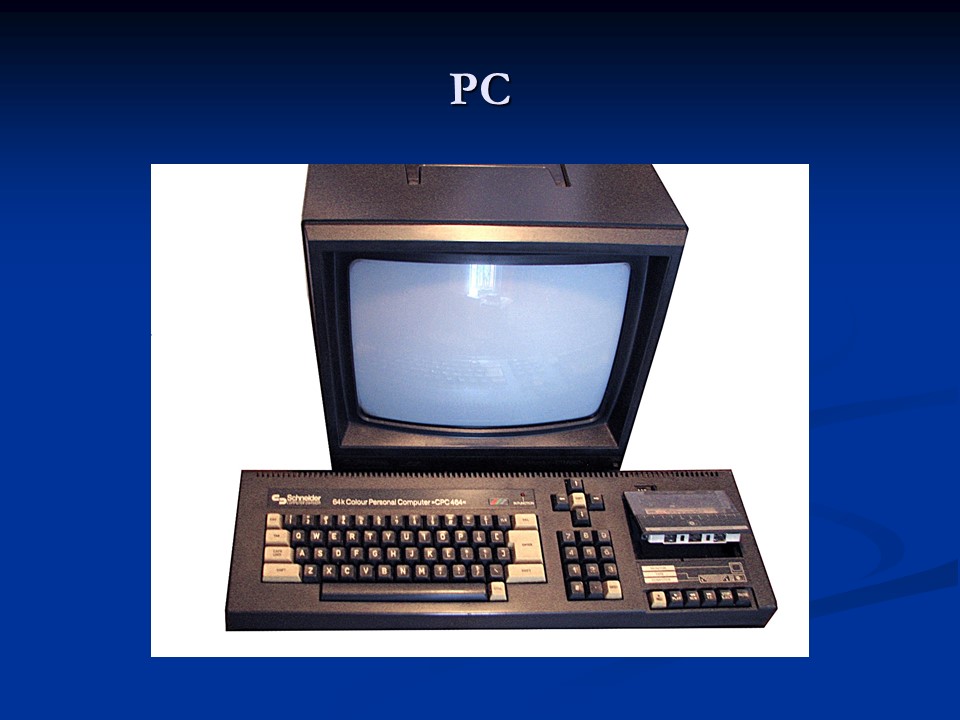
Here we see a version that involved magnetic tape data entry – the right side of the keyboard. The compartment and the tape cassette are visible.
Here we have the PC in all its glory.
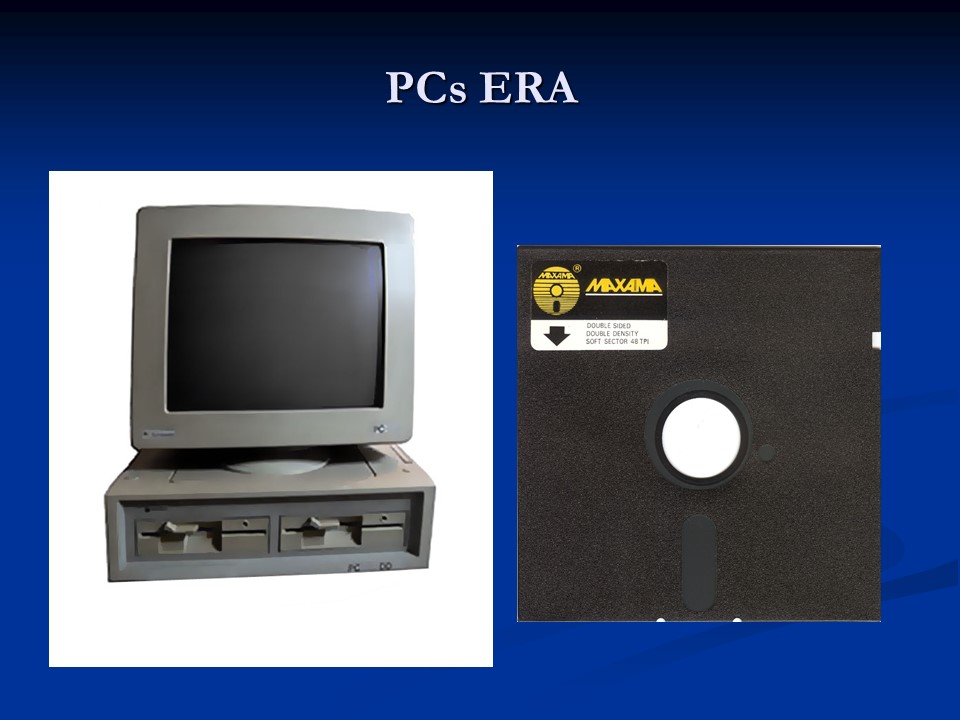
This model uses floppy disk drives, by means of which it was possible to enter any files with programs or data.
Another PC model. Note the change in the floppy disk drives. While the previous board showed a flexible large-size floppy disk, this one is smaller and was placed in a rigid case. The reduction in floppy disk size is also indicative of advances in data recording systems. Worth noting is the appearance of the mouse, which, obviously together with the still present keyboard, is used to communicate with the computer.

Under the supervision of Professor Jan Trąbka, the Department of Biocybernetics focused on publishing activities.

The Board also shows a lecture given by Professor Jan Trąbka at the next MCSB conference.
At that time, the Department of Biostatistics was also developing its own educational program.

Student computer labs located on the Market Square offered students individual computer workstations in the form of PCs. We not only taught students statistical methods, but also computer skills. Because personal computers were installed at every workstation, regardless of the type of work performed, we also organized courses for staff. Administration departments, patient care units and all diagnostic or therapeutic stations were equipped with suitable PCs connected to a computer network.
The second seat (apart from that used for teaching purposes) of the Department of Biostatistics and Medical Informatics was located in the loft at 17 Kopernika Street. The main LAN node of Collegium Medicum of the Jagiellonian University was also based here.
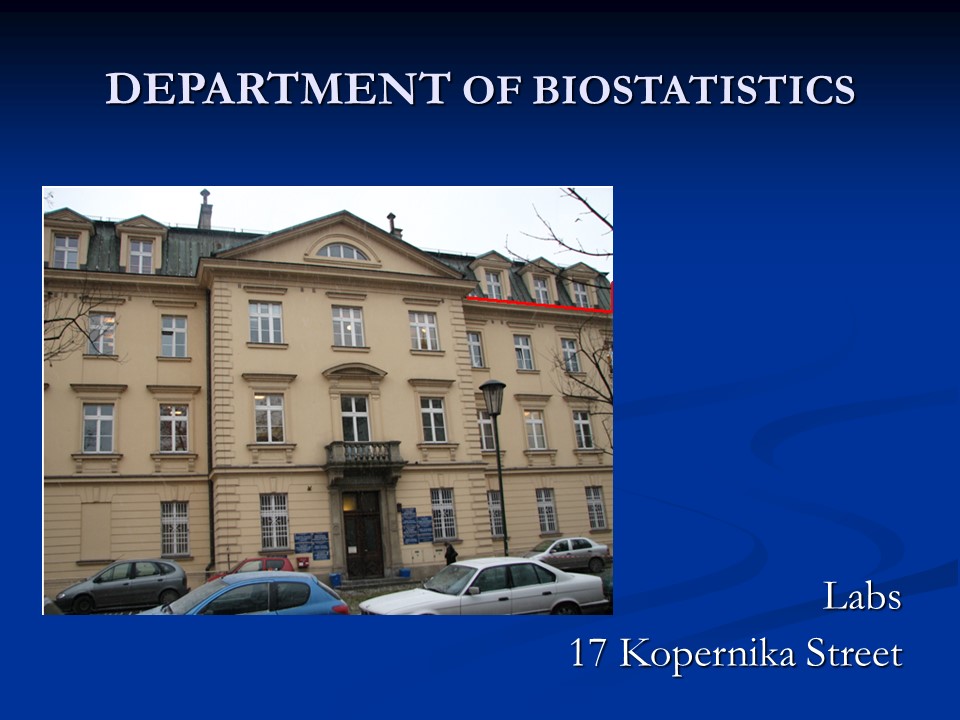
This photograph also acquires historical significance due to the relocation of the University Hospital to its new seat in Prokocim.
In addition to excellent personal computers, the Department was supplied with equipment with extensive graphic capabilities.
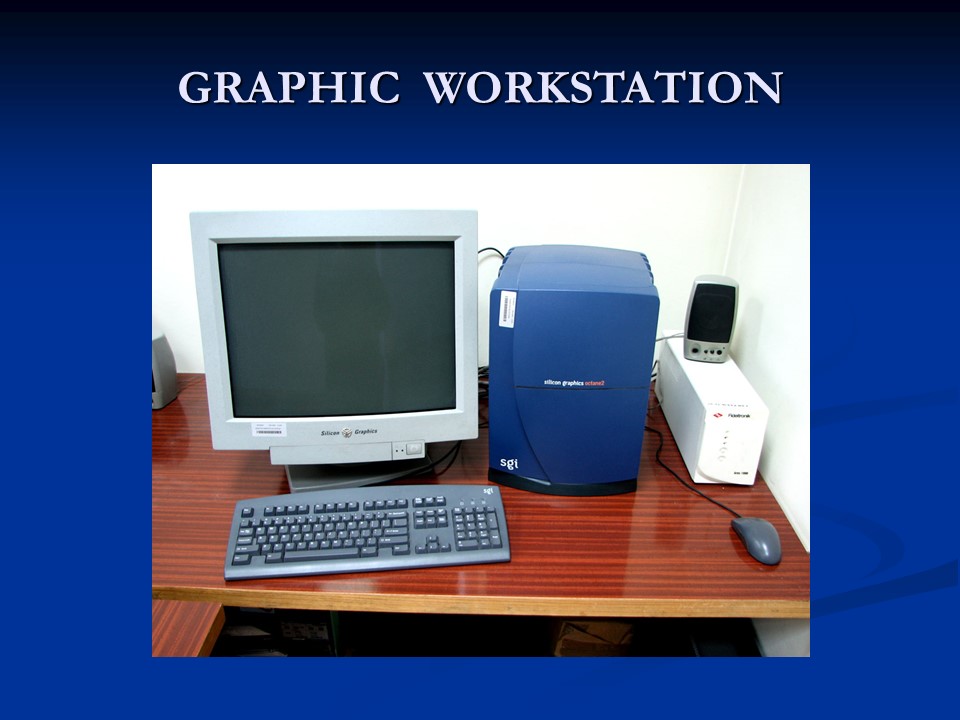
Shown in this picture is the Silicon Graphics workstation equipped with a color monitor enabling 3D visualization of objects. A viewed image can now be manipulated in a very flexible way – enabling zooming in, zooming out, rotating, changing the perspective of visualization, or selectively dimming certain components (e.g. we can selectively dim those components – organelles that don’t interest us from the image of tissues or cells).
The tradition of MCSB conferences continues – here are materials from 1995 and 2000.
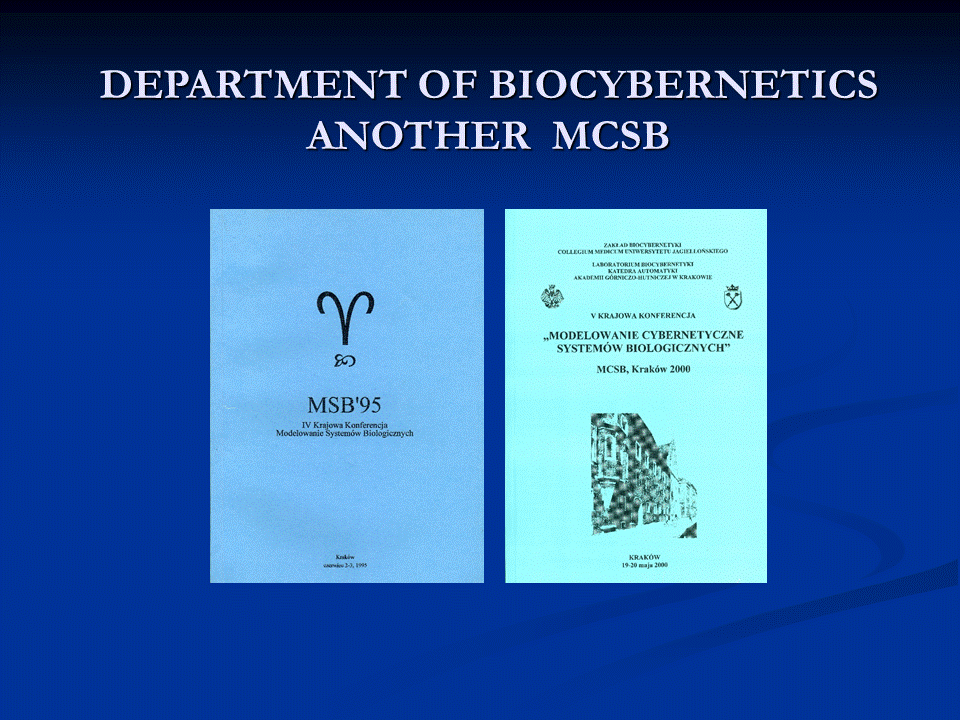
In 2002, two departments, the Department of Biocybernetics and the Department of Biostatistics were reunified under the directorship of Professor Ryszard Tadeusiewicz.
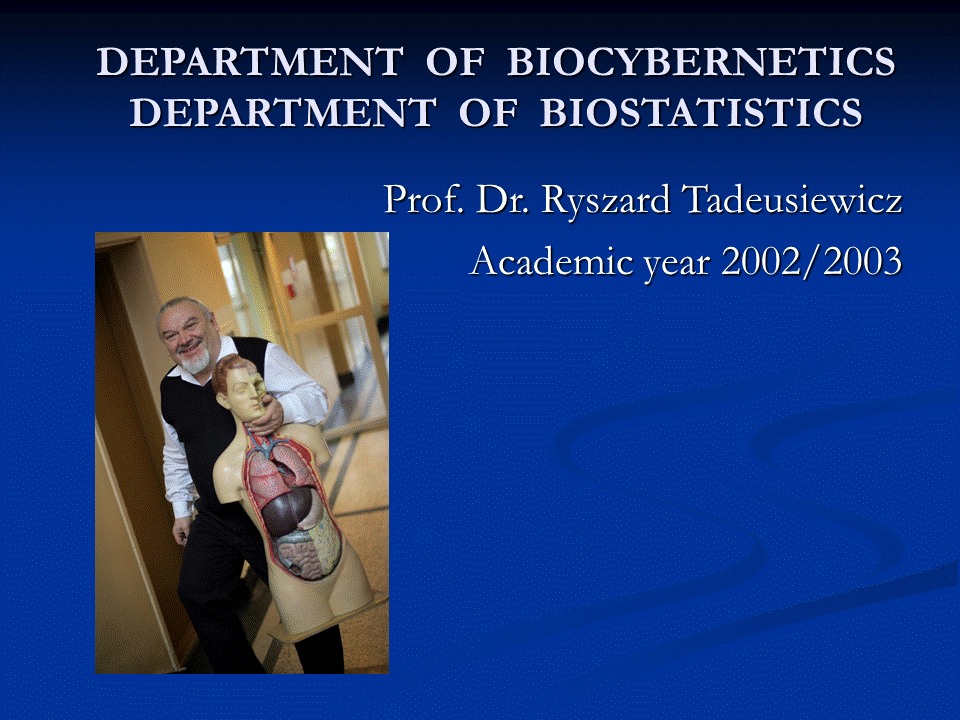
This event was proof of the continued spirit of cooperation. Professor Ryszard Tadeusiewicz continued to develop his own research work based on the “In Silico” simulation of many life processes.
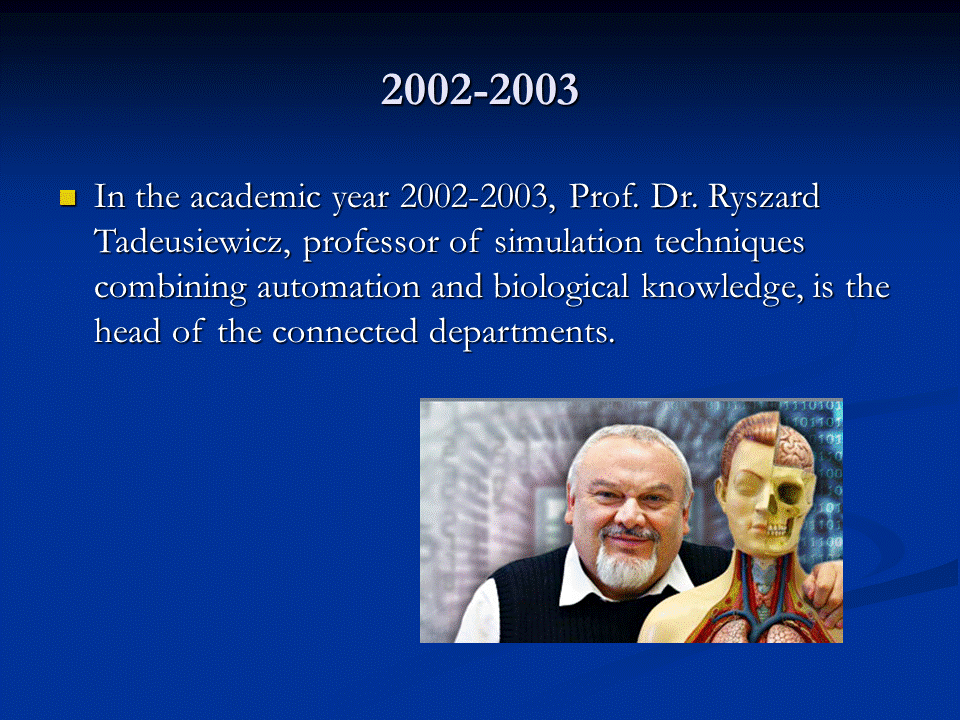
The fruits of this collaboration are visible. Numerous publishers and joint teaching programs have yielded promising results.
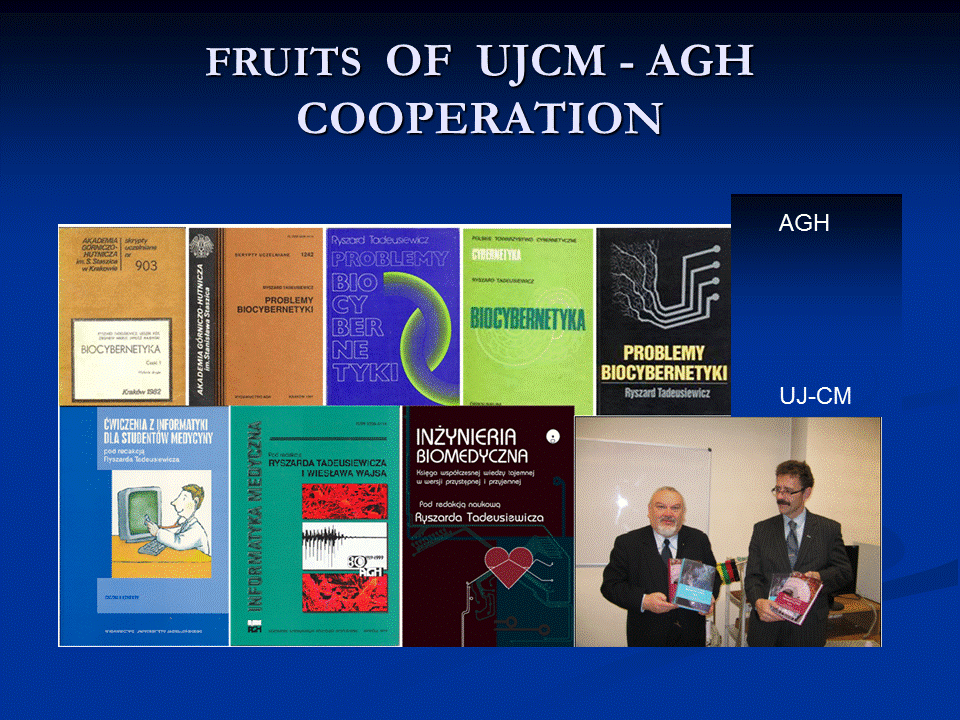
In 2003, Professor Irena Roterman-Konieczna was appointed head of the reunified unit, nowadays known as the Department of Bioinformatics and Telemedicine
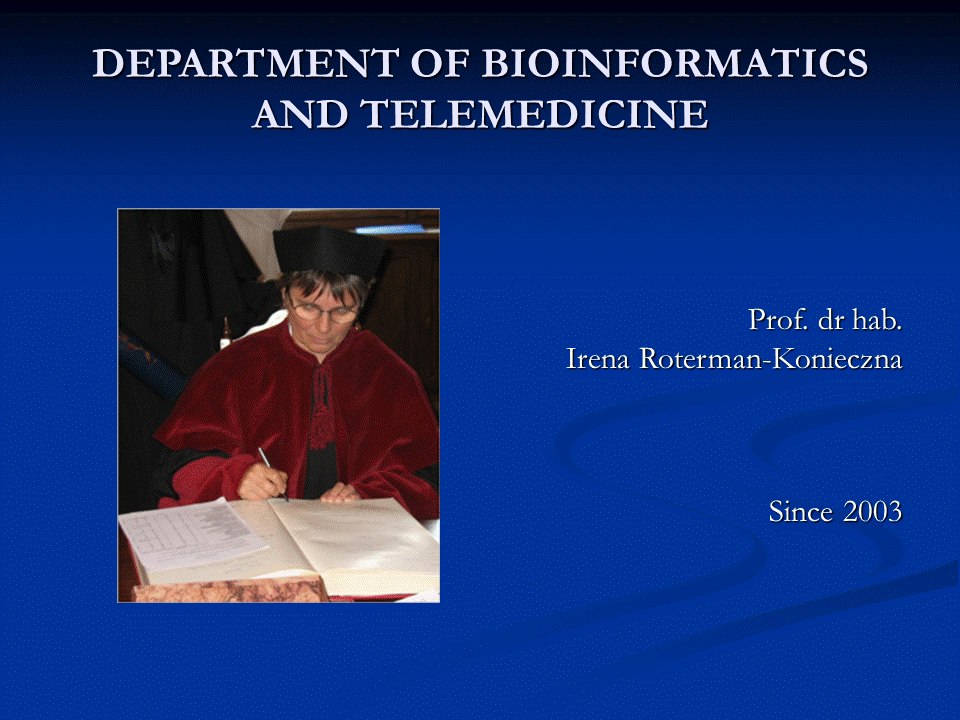
At the same time, we acquire possession of another new facility – this time in a newly erected building at 7e Kopernika Street. A whole floor belongs to us. Located on the ground floor is the Collegium Medicum Computer Center.
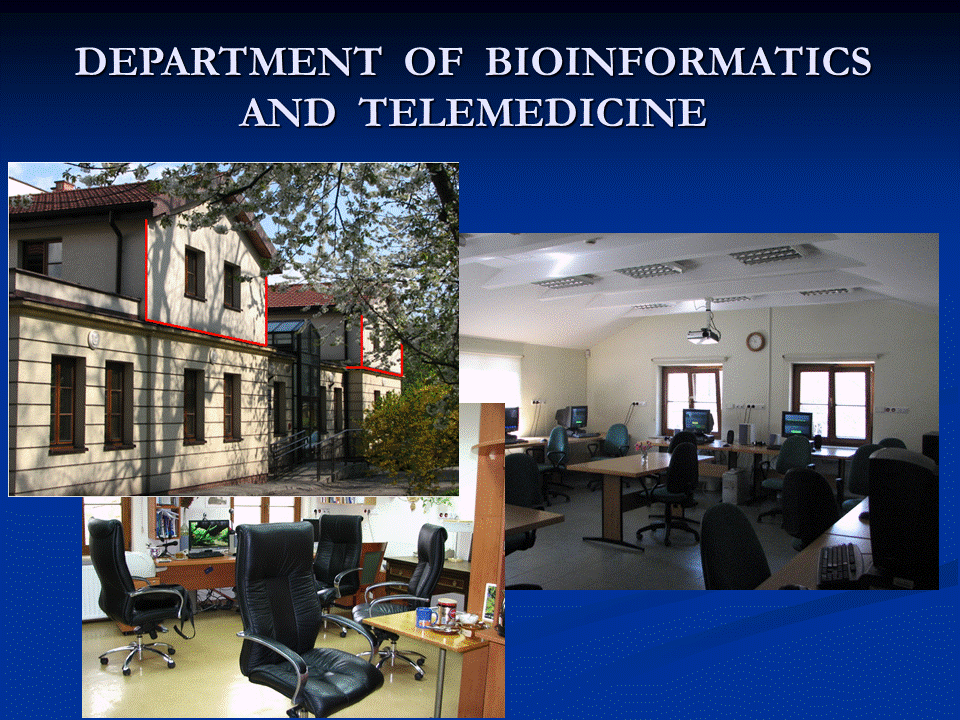
Staff and students have PC computers at their disposal, obviously with access to the Internet. The education we provide must keep pace with changes in the field of computerization. As a consequence, we teach students how to use the programs available on the Internet as well as the rules still applicable in medical data analysis based on statistical methods.
Our Department leaves its home at 17 Kopernika Street and moves into new premises in the the Teaching and Conference Center at 16 Św.Lazarza Street.
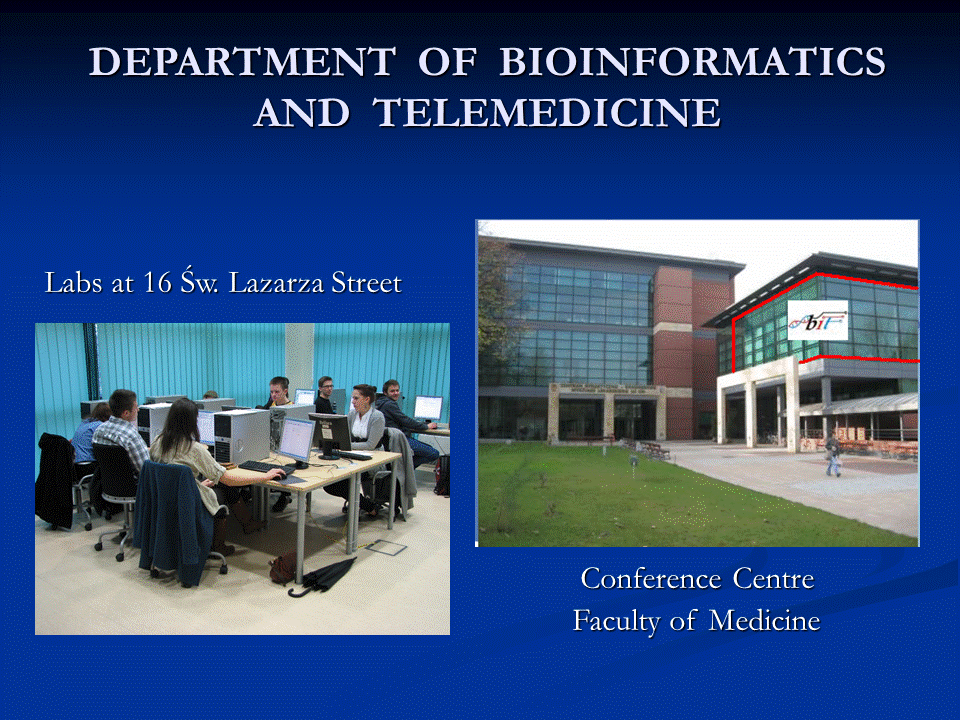
The room equipped with computers is intended for educational purposes.
The Department is becoming more active in terms of its publishing output. Worth mentioning here is the contribution of Andrzej Stanisz M.Sc in the form of numerous works on statistical analysis addressed specifically at the medical community.
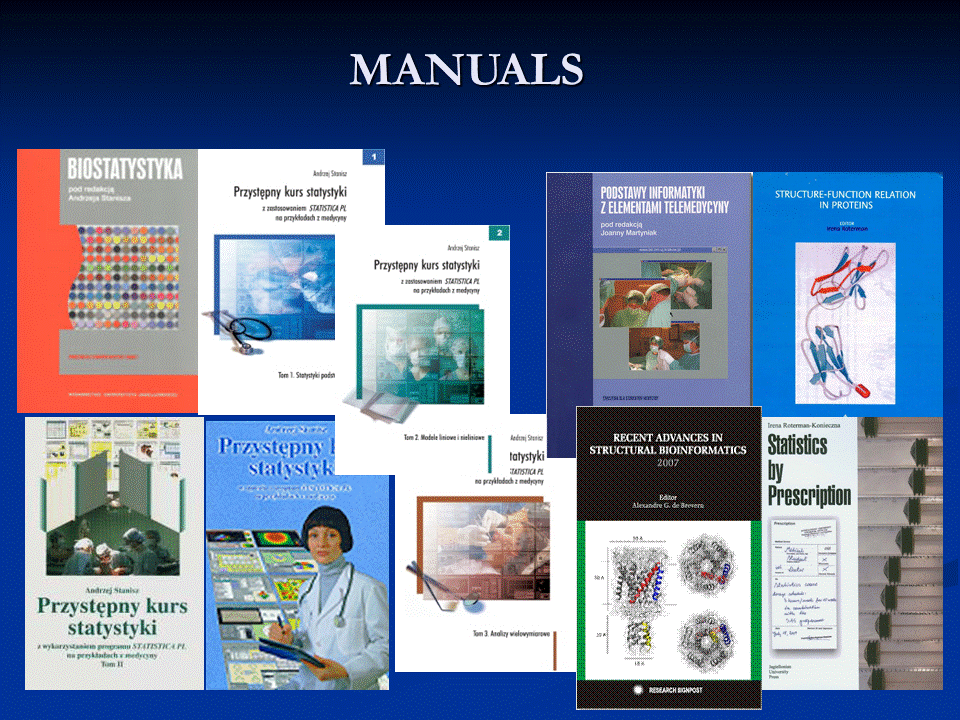
Abiding by the principle that if one doesn’t have one’s own website one does not exist at all, our Department launches its own online portal on which we present our research, teaching and organizational work.
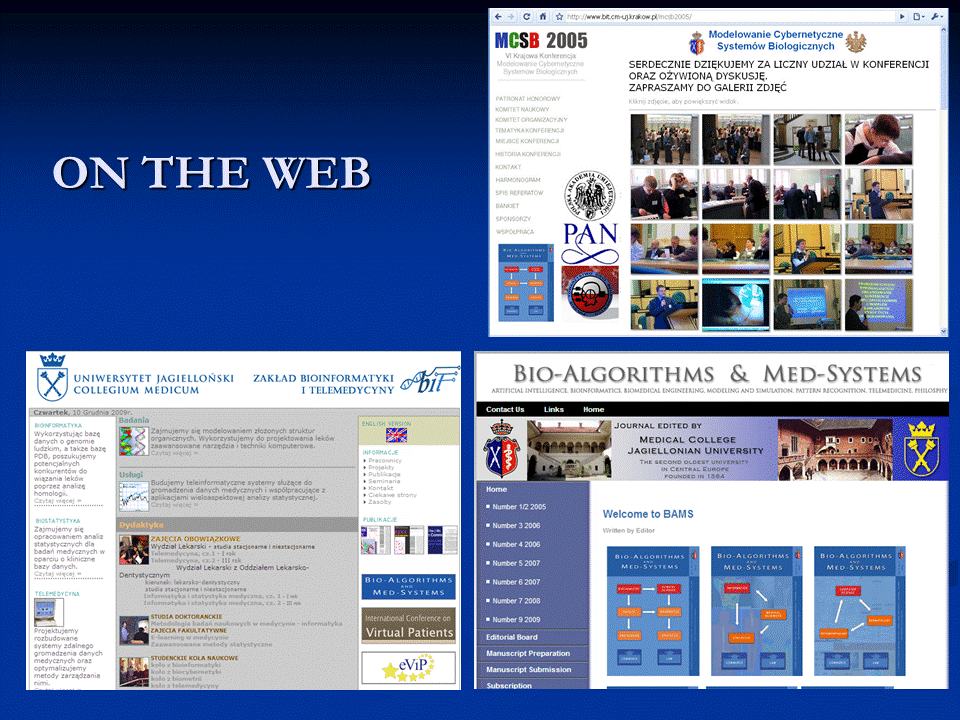
Computing power is significantly expanded. Computers at Cyfronet’s disposal on the GIGA scale increase the Department’s computing capabilities in relation to its first computer – the aforementioned Cyber.
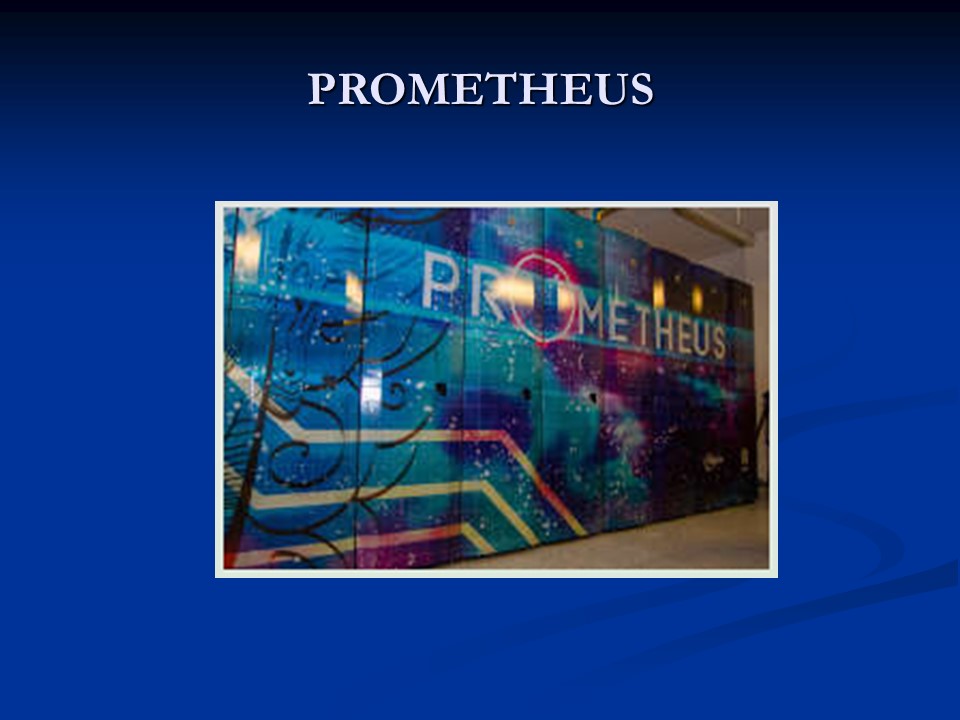
The recently launched PROMETEUSZ computer, which is being constantly expanded upgraded, is designed to support large-scale calculations made by the scientific community in Kraków. This computer appears in the TOP500 list of computers with the highest computing power in the world.
The Department’s active contributions to the field of bioinformatics are reflected in numerous publications, including several books. Drawing on its many years of experience in the teaching of statistics to medical students, the Department also prepared a textbook for this specific type of reader.
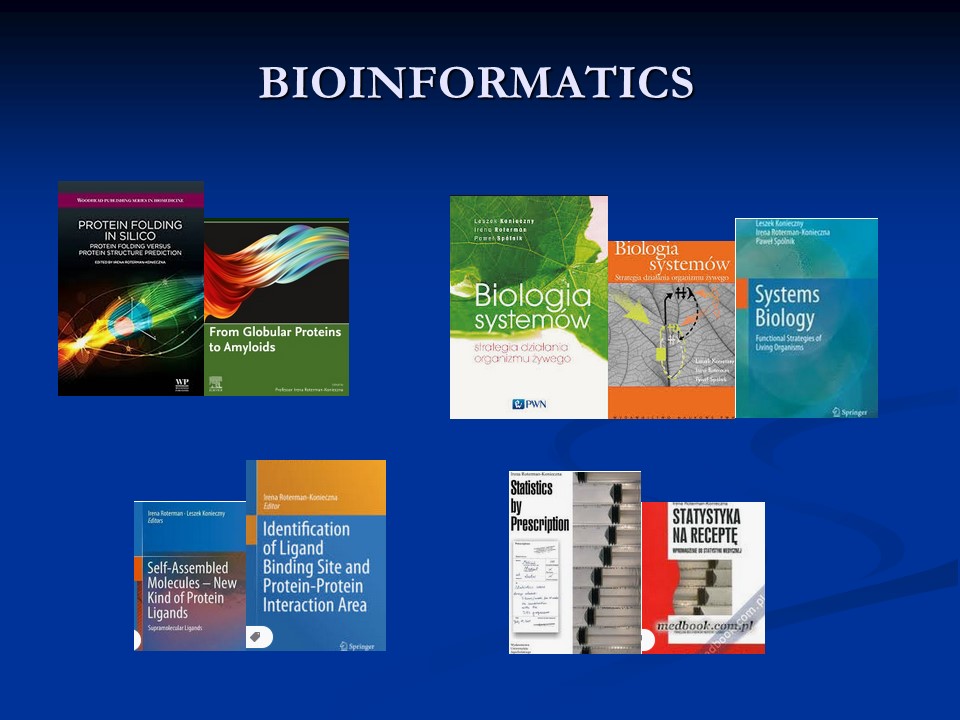
Education in medical simulation based on all forms of computer applications in this rapidly developing field has resulted in a number of book publications, in this case multi-author works.

Since 2005, our Department has been publishing its own journal – currently a quarterly called BIO-ALGORITHMS AND MED-SYSTEMS. We owe the continuity of its publication and the high standard of its content to Zdzisław Wiśniowski MSc.. Since 2012, the journal has been published by Walter de Gruyter. It is indexed, among other places, in the Web of Science and Scopus databases.

During the course of our history, we have been involved in several European undertakings:
We received the BRUSSELS award for our EuChinaGrid project, the aim of which was to develop international “Grid” computing infrastructure for the medical sciences. In the years 2012-13 and 2019-20 Professor Roterman engaged in bilateral cooperation in the field of bioinformatics simulations with French researchers (Pierre et Marie Curie University in Paris, Polonium grants).
New trends in the application of computers in medicine led to their increasing role in the clinical decision-making process. One example of the above was collaboration between the Department and the First Department of Cardiology (Professor Kalina Kawecka-Jaszcz, MD, PhD) in the European “Heartfaid” project, the aim of which was to support computer-aided decisions in cases involving patients with heart failure. Also worthy of mention here is a software package designed for building computer clinical pathways, developed in cooperation with a Swiss hospital.
There are also undertakisng in which computers support the medical education process. In this same area, the Department took part in the European eVIP project, in which, together with partner universities from Great Britain, Germany, the Netherlands, Sweden and Romania, it helped build a large database of interactive “virtual patient” clinical cases.
The Department is currently involved in three projects focused on modern education methods – BCIME – concerning software for designing and analyzing the curriculum (the so-called curriculum mapping); DID-ACT – methods of teaching clinical reasoning and MRAME – developing education based on augmented and mixed reality technologies. Computer technology in has had a beneficial role to play in the field of medical education during the current coronavirus pandemic, when remote learning is in many situations the only form of instruction available.
The introduction of remote technology for accessing data or even assisting patient-doctor contact has been another revolutionary step in the functional development of services in the healthcare system. These have also turned out to be life-saving innovations during the current public health emergency, as remote contact is a solution to many medical problems.
For telemedicine purposes, we use the Tele-Dicom program, which enables students to independently diagnose X-ray images using remote contact with a specialist. We obtained a license to use the Tele-Dicom program from the Department of Computer Science in the Faculty of Computer Science, AGH). We are also developing technology for transmitting and interpreting medical signals – multidimensional EEG analysis.
New technologies are emerging in the field of telemedicine. In this light, it is important to establish standards for the transmission of images used in medical imaging techniques in diagnostics and therapy. We have also launched telemedicine classes in her education program.
Since 2020, the Department of Bioinformatics and Telemedicine has been headed by Dr hab. Andrzej Kononowicz.
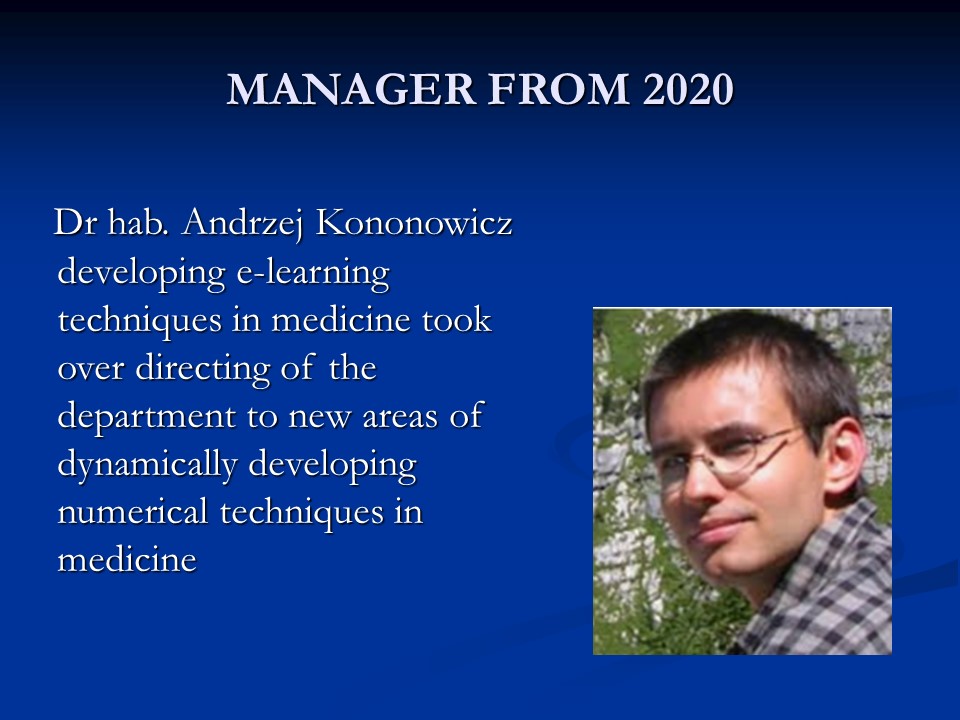
In accordance with tradition, the Department has also moved once more. Both the Director and manager and part of the Department previously based at 16 Łazarza Street have been transferred to 7 Medyczna Street in Prokocim. Our new location also provides us with a new neighbor, i.e. the Center for Innovative Medical Education. Cooperation with this institution will probably bear fruit in the disciplines of medical process simulation and medical education with the help of E-learning techniques.

